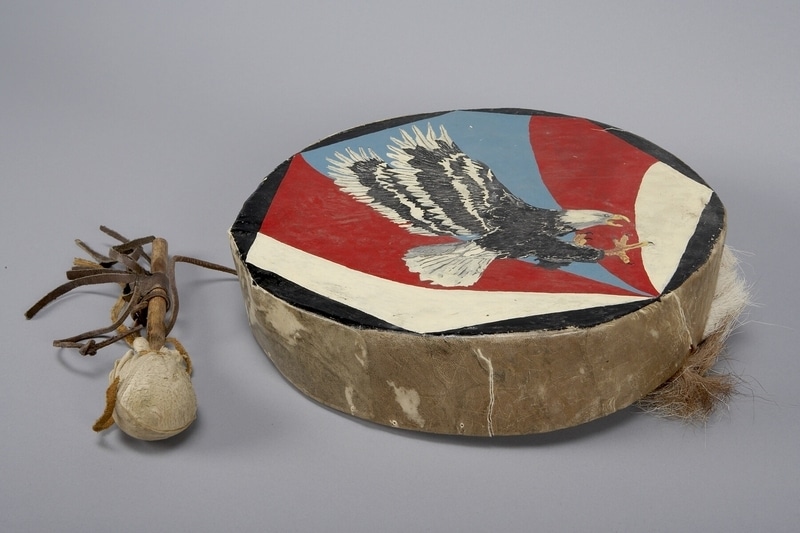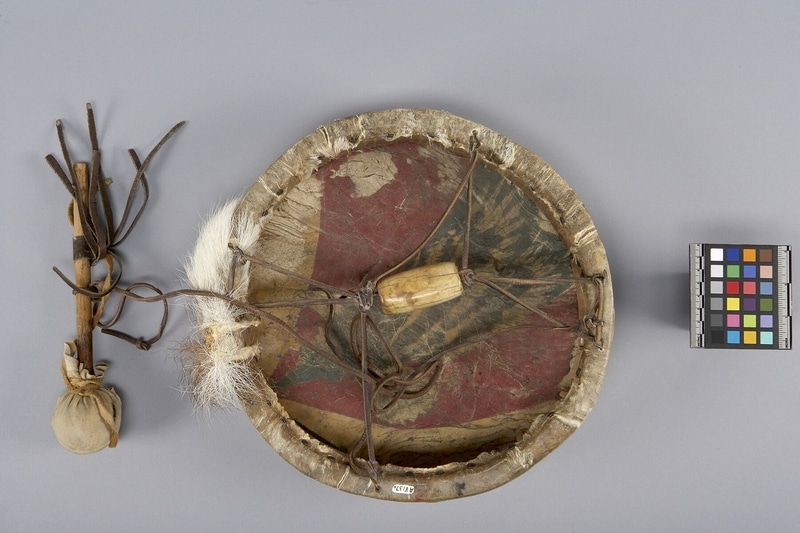Dance Drum Item Number: A8137 a-b from the MOA: University of British Columbia



Description
Circular drum (a) with attached drumstick (b). The drum hide is stretched over a circular wooden frame and secured by nails. It still has some fur remaining on one side. On the back, leather thongs with a bone secured in centre form a handgrip. An eagle with raised wings is painted in black, white, ygrey and yellow against an abstract background of blue, red, off-white and black. The drumstick consists of a a spherical head covered in off-white skin, a cylindrical wooden shaft, and a strip of brown leather fastened around the shaft with the ends split into several thinner strips.
Cultural Context
ceremonial
Iconographic Meaning
Hillary Stewart notes that on the Northwest Coast the eagle is "a symbol of power and prestige...Many myths and legends surround the Eagle; eagle down, a symbol of peace and friendship, was, and still is, sprinkled before guests in welcome dances and on other ceremonial occasions (1976:54)."
Specific Techniques
Anthropologist William Elmendorf notes that: "The skin drum was a tambourine with single-skin head of uncured deer hide. During the reservation period horsehide came to be preferred for its louder tone. The single head was stretched across a circular frame of wood, usually a vine maple hoop. The head skin covered the side of the wood frame and was held taught by thong lacings. The frame was thin, one to three feet in diameter, three to four inches deep. It was made of a single piece of wood, bent with the aid of hot water (1960:221)."
Narrative
An old dance drum with an ivory gambling game piece for a handle. The design was repainted for the Indigenous production of "Tzin'kwa" .
Item History
- Made in British Columbia, Canada
- Collected in Duncan, British Columbia, Canada between 1950 and 1962
- Owned by Edith Bevan Cross before July 30, 1962
- Received from Edith Bevan Cross (Seller) and H. R. MacMillan (Funding source) on July 30, 1962
What
Who
- Culture
- Coast Salish: Quwutsun'
- Previous Owner
- Edith Bevan Cross
- Received from
- Edith Bevan Cross (Seller) and H. R. MacMillan (Funding source)
Where
- Holding Institution
- MOA: University of British Columbia
- Made in
- British Columbia, Canada
- Collected in
- Duncan, British Columbia, Canada
When
- Collection Date
- between 1950 and 1962
- Ownership Date
- before July 30, 1962
- Acquisition Date
- on July 30, 1962
Other
- Condition
- fair
- Current Location
- Case 7
- Accession Number
- 0081/0121